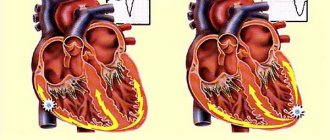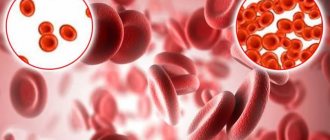Can high temperature cause complications on the heart: a cardiologist's view
Numerous microorganisms - bacteria, viruses, fungi and other protozoa - can have a direct damaging effect on the heart muscle. However, in most cases, myocardial damage is observed as a secondary phenomenon, a complication of viral and bacterial diseases.
The effect of hyperemia on the functioning of the body
The penetration of infectious agents into the human body causes a natural response of the immune system aimed at suppressing their vital functions. The essence of the process comes down to the following: microbes, having penetrated the tissues of the body, release toxic substances, which are protein compounds. The presence of foreign elements initiates a series of biochemical reactions for the active synthesis of specific antibodies. The thermoregulation center of the brain is activated, which leads to a rise in temperature - hyperthermia, the companion of which is a feverish state.
High temperature is a factor that forces the heart to work in an “emergency” mode due to disruptions in metabolic metabolism, changes in the quantitative and qualitative composition of the blood, and rapid disruption of the water-salt balance. Hyperemia is manifested by an increase in the frequency of myocardial contractions, a rise in blood pressure, and centralization of blood flow. Poor blood circulation is the cause:
- headache;
- dizziness;
- seizures;
- fainting states.
Complications
Detailed diagnostic methods that cardiology in Nizhny Novgorod has in its arsenal show: in cardiac patients with hyperemia, sinus arrhythmia is recorded. Patients with fever are at risk of dangerous conditions: acute heart failure, persistent increase in the number of red blood cells - polycythemia. Hyperemia poses a threat of chronic insufficiency of cerebral blood flow and the development of a critical condition - DIC syndrome: acquired disorders of the coagulation capabilities of the circulatory system. At the same time, a sharp drop in temperature caused by taking powerful antipyretic drugs can provoke a decrease in blood pressure to critical values, which poses a threat of collapse.
One of the common ailments that is accompanied by hyperemia is tonsillitis - an inflammatory process that affects the palatine tonsils. Often, after suffering from a sore throat, especially with inadequate and not comprehensive therapy, severe complications of the disease from the cardiovascular system occur. Among the dangerous consequences of tonsillitis is acute rheumatic fever, which destroys the myocardium, endocardium, and pericardium. Chronic rheumatic heart disease may develop, the frequent outcome of which is an acquired defect, a malfunction of the valve system.
Another unfavorable outcome of angina is myocarditis - an inflammatory lesion of the heart muscle, causing disruption of all functions of the organ. Tonsillogenic cardiopathy also includes myocardial dystrophy. A dangerous consequence of streptococcal infections is acute septic endocarditis.
Therefore, at the first signs of viral or infectious diseases and an increase in temperature, it is necessary to urgently seek medical help for differential diagnosis and choice of treatment strategy.
Announcement: Women often ignore dangerous symptoms that indicate an approaching heart attack. Knowing these signs could one day save a life.
For some reason, it is generally accepted that men suffer from heart attacks more often than women. In fact, women over 50 have the same heart attack rate as men of the same age. Another thing is that not everyone is equally attentive to their health and rushes to see a doctor when dangerous signs appear. It is important to consider that the pre-infarction condition in men and women is manifested by different symptoms. The following 8 typical signs most often indicate an approaching heart attack in women. 1. Numbness in the hands It appears suddenly and does not last long, so most often this symptom is ignored. Women believe that they simply went to bed in an uncomfortable position or overworked their hand. Numbness, weakness, pain in the left arm predicts an approaching heart attack. It is important to get a cardiogram as soon as possible. 2. Toothache Usually the pain is aching in nature, spreading to the entire jaw. In fact, the source of the problem may not be tooth decay, but heart problems. If there are no obvious reasons for tooth pain, it is worth undergoing cardiac diagnostics. 3. Nausea and vomiting Two out of three volunteers who took part in a scientific study after a heart attack reported feeling stomach pain before the attack, and experienced nausea and even vomiting for several days. Men mention such previous symptoms in half of the cases. 4. Difficulty breathing With poor blood circulation, the body experiences a lack of oxygen, which manifests itself in the appearance of shortness of breath. A heart attack causes blood to stop circulating properly, causing fluid to accumulate in the lungs. Lack of air is a dangerous symptom, whatever its causes. It is necessary to consult a doctor to determine the cause of the dangerous condition. 5. Severe weakness If no changes occur in the rhythm of life, and fatigue becomes stronger every day, this indicates overwork or an approaching heart attack. Many women who have had a heart attack report that in the days leading up to it, they were unable to shower, move, or carry out daily activities as easily as before. 6. Back pain Usually this symptom appears immediately before an attack and is the only one. Acute pain in the area between the shoulder blades without any previous injuries, falls or other causes indicates problems with the heart. You should urgently contact a cardiologist. 7. Strange feeling in the chest Tightness, some unclear, but unfamiliar and unpleasant sensations in the chest may indicate that something bad is happening to the blood vessels. For example, a blockage has occurred, or the heart muscle has lost the ability to push blood through at the same rhythm. Together with the above symptoms, this is a very alarming sign that should not be ignored. 8. Flu symptoms Over the age of 55, you should be very attentive to flu-like symptoms when there is reason to suspect heart problems. A common cold can provoke an exacerbation of cardiovascular diseases. During the examination, you should definitely visit a cardiologist and perform a cardiogram.
Why does saturation decrease during coronavirus?
Not all patients with COVID-19 have a decrease in saturation, but only with the development of a complication - viral pneumonia. A decrease in saturation indicates probable respiratory failure. If a coronavirus infection has penetrated the lung tissue, and a person’s immune system cannot cope with it, a destructive process begins in the lungs - the alveolar septa (and interstitium) are damaged and inflamed, and the alveoli themselves are filled with liquid exudate - normally they are filled with air and are the starting point of transportation oxygen to organs, including the heart and brain. Since there is no damage to the bronchial tree with coronavirus, a decrease in saturation in a patient may indicate a reduction in the functional areas of the lung tissue.
If coronavirus saturation is below 95%, the patient may be hospitalized.
If the temperature is low
It happens that with ARVI, the thermometer freezes at below 360C. How to feel about this and what to do? Hypothermia can be caused by excessive sweating. You need to wipe your armpit dry and measure your temperature again. A temperature reaction that is inadequate to the general condition often occurs in older people, pregnant women, and patients with severe concomitant diseases and endocrine pathologies. Sometimes the cause of hypothermia is the abuse of antipyretic drugs, so you should always strictly follow the instructions for taking the drug. Even if the temperature is normal, you should not ignore the symptoms of ARVI: the less nasal congestion and the less frequent sneezing, the less viruses will spread. The combined drug TheraFlu for colds and flu has antipyretic, anti-inflammatory, decongestant, analgesic and antiallergic effects, which helps improve well-being5 even at normal and low body temperature. In any case, if cold symptoms appear, you should consult a doctor. After all, only a specialist can adequately assess the condition and symptoms of the disease and select the necessary treatment.
What to do if the temperature does not go away?
Contact the clinic. If you cannot determine which specialist you need, you should start with a therapist - he will assess your general condition and recommend that you take tests that will give a more objective picture (usually a general blood and urine test).
Our clinic provides a full range of medical services in all areas - our allergists, surgeons, gynecologists, urologists, gastroenterologists, and dozens of doctors of other specialties will provide you with qualified assistance. Here, in the clinic, you can undergo all the necessary tests. A serious plus is that all examinations and treatment measures will be carried out at a time convenient for you.
If you have previously been diagnosed with diseases that have become chronic, be sure to inform the doctor about them during your appointment - this will make it easier for him to navigate the list of examinations that you need to undergo.
"Useful" temperature
Increased body temperature (fever) is one of the main symptoms of ARVI. Viruses and toxins that are formed during inflammation act on the thermoregulation center located in the brain. As a result, it switches to a different mode of operation, changing the functioning of the cardiovascular, respiratory, nervous, endocrine and immune systems. Metabolic processes are accelerated, and this is accompanied by the formation of a large amount of thermal energy. An increase in temperature is accompanied by chills, contraction of muscles and superficial vessels of the skin. Blood rushes into the body. This prevents the body from getting rid of excess heat and contributes to the development of fever2. Despite its clearly pathological nature, fever can be considered beneficial for the body. As the temperature rises, immunity strengthens and the activity of leukocytes – white blood cells that stand in the way of microbial aggression – increases. This helps the body fight infection3.
Temperature that does not need to be reduced
The fever itself is not dangerous, and if the body temperature does not exceed 38.50 C, you can not bring it down1. Another question is that this worsens overall well-being. Along with the temperature (and sometimes regardless of it), a feeling of weakness, weakness, unmotivated fatigue, drowsiness, headache and muscle aches appear3. The picture is complemented by the symptoms of ARVI: runny nose, nasal congestion, sneezing, sore and sore throat, cough and other signs of respiratory tract damage. The main emphasis should be on combating these manifestations of the disease. Complex medications, such as TheraFlu for colds and flu, help reduce the severity of symptoms4. Thanks to the combination of several active components, TheraFlu fights headaches, body aches, nasal congestion, sneezing and other manifestations of ARVI5, regardless of whether the body temperature is elevated4.
Diagnosis of myocarditis
For diagnostics
of myocardium, instrumental and laboratory methods are used, as well as myocardial biopsy.
Instrumental methods include:
- ECG - rhythm and conduction disturbances may be detected for the first time, sometimes infarction-like changes (especially in the acute phase of inflammation);
- ECHO CG - disturbances in systolic (due to the death of cardiomyocytes) and diastolic (due to swelling of the walls of the left ventricle) myocardial function;
- MRI contrast with gadolinium clearly reveals edema of the heart wall (as one of the stages of inflammation), but can be false negative;
- Myocardial scintigraphy can be informative in cases of suspected sarcoid myocarditis, but in other cases it is not very specific.
Laboratory methods include:
- A clinical blood test that can reveal an increase in ESR, an increase in the number of leukocytes, and in some forms, eosinophils;
- A study of the value of the so-called cardiac-specific enzymes (troponin T and CPK) reveals their increase, but a negative result does not exclude the diagnosis of myocarditis;
- Determination of serum antimyocardial antibodies.
- Routine serological viral testing is not recommended; it may only be useful in diagnosing diphtheria or borreliosis myocarditis
The gold standard for diagnosing myocarditis is endomyocardial myocardial biopsy (EMB), which is performed only in specialized hospitals and according to strict indications. Indications for referral are determined by the attending physician.









